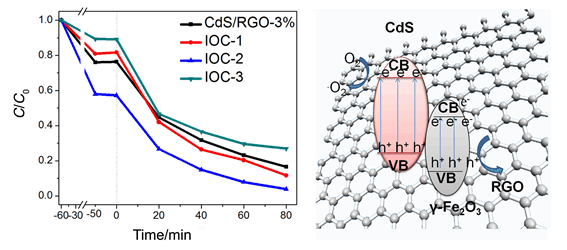| [1] Aarthi, T.; Narahari, P.; Madras, G. J. Hazard. Mater. 2007, 149, 725.
[2] Gu, S. H.; Wang, L. Z.; Zhang, J. L. Chin. J. Chem. 2017, 35, 153.
[3] Higashimoto, S.; Hikita, K.; Azuma, M. Chin. J. Chem. 2017, 35, 165.
[4] Wang, J. T.; Xiao, C.; Wu, X. Y. Chin. J. Chem. 2017, 35, 189.
[5] Li, X. D.; Zhang, Q. H.; Wang, H. Z. Chin. J. Chem. 2017, 35, 196.
[6] Qin, H. X.; Bian, Y. Y.; Zhang, Y. X. Chin. J. Chem. 2017, 35, 203.
[7] Cui, S. Z.; Yang, H. P.; Sun, H. H. Acta Chim. Sinica 2016, 74, 995. (崔素珍, 杨汉培, 孙慧华, 聂坤, 吴俊明, 化学学报, 2016, 74, 995.)
[8] Carey, J. H.; Lawrence, J.; Tosine, H. M. B. Environ. Contam. Tox. 1976, 16, 697.
[9] Wang, E. J.; Yang, H. Y.; Cao, Y. A. Acta Chim. Sinica 2009, 67, 2759(in Chinese). (王恩君, 杨辉云, 曹亚安, 化学学报, 2009, 67, 2759.)
[10] Bae, E.; Choi, W. Environ. Sci. Technol 2003, 37, 147.
[11] Wang, Y. W.; Zhu, Y. H.; Yang, X. L. Chin. J. Chem. 2017, 35, 949.
[12] Chang, J.; Zhang, W. J.; Hong, C. Y. Chin. J. Chem. 2017, 35, 1016.
[13] Jiang, L. P.; Wang, S. J.; Shi, L. Y. Chin. J. Chem. 2017, 35, 183.
[14] Cheng, J. S.; Wang, W. H.; Zhu, W. J. Chin. J. Chem. 2016, 34, 53.
[15] Wang, D. B.; Zhao, L. X.; Guo, L. H.; Zhang, H.; Wan, B.; Yang, Y. Acta Chim. Sinica 2015, 73, 388(in Chinese). (王大彬, 赵利霞, 郭良宏, 张辉, 万斌, 杨郁, 化学学报, 2015, 73, 388.)
[16] Bi, F.; Muhammad, F.; Liu, W. Chin. J. Chem. 2015, 33, 112.
[17] Abe, R.; Takata, T.; Sugihara, H. Chem. Commun. 2005, 30, 3829.
[18] Higashi, M.; Abe, R.; Teramura, K. Chem. Phys. Lett. 2008, 452, 120.
[19] Li, C. Q.; Luo, L. T.; Xiong, G. W. Acta Chim. Sinica 2010, 68, 1023(in Chinese). (李长全, 罗来涛, 熊光伟, 化学学报, 2010, 68, 1023.)
[20] Ba-Abbad, M. M.; Kadhum, A. A. H.; Mohamad, A. B. Int. J. Therm. Environ. Eng. 2010, 1, 37.
[21] Xie, Y. P.; Yu, Z. B.; Liu, G.; Ma, X. L.; Cheng, H. M. Energy. Environ. Sci. 2014, 7, 1895.
[22] Zhang, N.; Zhang, Y.; Pan, X.; Yang, M. Q.; Xu, Y. J. J. Phys. Chem. C, 2012, 116, 18023.
[23] Ye, X. J.; Dai, X.; Meng, S. G. Chin. J. Chem. 2017, 35, 217.
[24] Kashiath, L.; Namratha, K.; Byrappa, K. J. Alloy. Compd. 2016, 695, 799.
[25] Lee, J.; Kim, Y.; Kim, J. K.; Kim, S.; Min, D.; Jang, D. Appl. Catal. B 2017, 205, 433.
[26] Khan, S.; Han, J. S.; Lee, S. Y. Chin. J. Chem. 2017, 35, 159.
[27] Cong, R. M.; Luo, Y. J.; Yu, H. Q. Acta Chim. Sinica 2012, 68, 1971(in Chinese). (丛日敏, 罗运军, 于怀清, 化学学报, 2012, 68, 1971.)
[28] Li, H. J.; Zhou, Y.; Chen, L.; Luo, W. J.; Xu, Q. F.; Wang, X. Y.; Xiao, M.; Zou, Z. G. Nanoscale 2013, 5, 11933.
[29] Vaquero, F.; Navarro, R. M.; Fierro, J. L. G. Appl. Catal. B 2017, 753.
[30] Li, Q.; Guo, B. D.; Yu, J. G.; Ran, J. R.; Zhang, B. H.; Yan, H. J.; Gong, J. R. J. Am. Chem. Soc. 2011, 133, 10878.
[31] Li, Y. G.; Wei, X. L.; Li, H. J.; Wang, R. R.; Feng, J.; Yun, H.; Zhou, A. N. RSC Adv. 2015, 5, 14704.
[32] Liu, X. J.; Pan, L. K.; Lv, T.; Zhu, G.; Sun, Z.; Sun, C. Q. Chem. Commun. 2011, 47, 11984.
[33] Zhang, Y. H.; Tang, Z. R.; Fu, X. Z.; Xu, Y. J. ACS Nano 2010, 4, 7303.
[34] Zhang, N.; Yang, M. Q.; Liu, S. Q.; Sun, Y. G.; Xu, Y. J. Chem. Rev. 2015, 115, 10307.
[35] Quan, Q.; Lin, X.; Zhang, N.; Xu, Y. J. Nanoscale 2017, 9, 2398.
[36] Han, C.; Zhang, N.; Xu, Y. J. Nano Today 2016, 11, 351.
[37] Yuan, L.; Yang, M. Q.; Xu, Y. J. Nanoscale 2014, 6, 6335.
[38] Liu, Y.; Zhou, L.; Hu, Y.; Guo, C. F.; Qian, H. S.; Zhang, F. M.; Lou, X. W. J. Mater. Chem. 2011, 21, 18359.
[39] Li, N.; Zhang, J.; Tian, Y.; Zhao, J. H.; Zuo, W. Chem. Eng. J. 2017, 308, 377.
[40] Chen, Y.; Liu, K. R. J. Alloy. Compd. 2017, 697, 161.
[41] Jia, X. H.; Dai, R. R.; Lian, D. D.; Han, S.; Wu, X. Y.; Song, H. J. Appl. Surf. Sci. 2017, 392, 268.
[42] Wang, L.; Wei, H. W.; Fan, Y. J.; Gu, X.; Zhan, J. H. J. Phys. Chem. C 2009, 113, 14119.
[43] Liu, Y.; Yu, L.; Hu, Y.; Guo, C. F.; Zhang, F. M.; Lou, X. W. Nanoscale 2012, 4, 183.
[44] Zhang, L.; Wu, H. B.; Madhavi, S.,; Hng, H. H.; Lou, X. W. J. Am. Chem. Soc. 2012, 134, 17388.
[45] He, H.; Klinowski, J.; Forster, M. Chem. Phys. Lett. 1998, 287, 53.
[46] Singh, A. P.; Mishra, M.; Sambyal, P.; Gupta, B. K.; Singh, A.; Dhawan, S. K. J. Mater. Chem. A 2014, 2, 3581.
[47] Meng, N. N.; Zhou, Y. F.; Nie, W. Y.; Chen, P. P. J. Nanopart. Res. 2016, 18, 241.
[48] Kudin, K. N.; Ozbas, B.; Schniepp, H. C. Nano Lett. 2008, 8, 36.
[49] Sirivisoot, S.; Harrison, B. S. Int. J. Nanomedicine 2015, 10, 4447.
[50] Xu, J.; Wang, L.; Cao, X. J. Chem. Eng. J. 2016, 283, 816.
[51] Jia, L.; Wang, D. H.; Huang, Y. X.; Xu, A. W.; Yu, H. Q. J. Phys. Chem. C 2011, 115, 11466.
[52] Guo, R. Q.; Fang, L.; Dong, W.; Zheng, F. G.; Shen, M. R. J. Mater. Chem. 2011, 21, 18645.
[53] Mondal, S.; Sunhu, S.; Bhattacharya, S.; Saha, S. K. J. Phys. Chem. C 2015, 119, 27749. |
